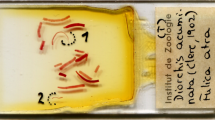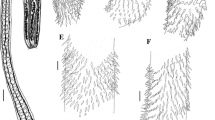Abstract
Sawadalepis n. g. is erected for Sawadalepis prima n. sp. in Schreiber’s bent-winged bat Miniopterus schreibersii Kuhl (Chiroptera: Vespertilionidae) from southern China. Diagnostic features of the currently monotypic genus include attributes of the osmoregulatory system and female genital organs. The dorsal osmoregulatory canals are shifted bilaterally towards the margins of proglottides in relation to the ventral canals. The genital pores are unilateral and sinistral. Among female attributes, the copulatory part of the vagina is covered externally by a dense layer of intensely stained cells; the conductive part of the vagina is clearly distinguishable from the seminal receptacle; the uterus has ventral and dorsal diverticula, extending bilaterally beyond the longitudinal osmoregulatory canals; and the eggs are spherical with thick outer coat.



Similar content being viewed by others
References
Andreiko, O. F., Skvortsov, V. G., & Konovalov, Y. N. (1969). [Tapeworms of bats in Moldavia.] In: Spassky, A. A. (Ed.), Parasites of vertebrates. Kishinev: Izdatel’stvo Kartya Moldovenyaske, pp. 31–36) (In Russian).
Czaplinski, B., & Vaucher, C. (1994). Family Hymenolepididae Ariola, 1899. In: Khalil, L. F., Jones, A. & Bray, R. A. (Eds.), Keys to the Cestode Parasites of Vertebrates. Wallingford, UK: CAB International, pp. 595–663.
Greiman, S. E., & Tkach, V. V. (2012). Description and phylogenetic relationships of Rodentolepis gnoskei n. sp. (Cyclophyllidea: Hymenolepididae) from a shrew Suncus varilla minor in Malawi. Parasitology International, 61, 343–350.
Gulyaev, V. D., Makarikova, T. A., & Makarikov, A. A. (2008). [On symmetry of strobilae of Cyclophyllidea with unilateral location of genital atriums.] Proceedings of a scientific conference dedicated to the 130 year from acad. K.I. Skrjabin’s birthday (Moscow, 9–11 December 2008). Moscow: Russian Academy of Sciences, pp. 93–95 (In Russian).
Gulyaev, V. D., & Melnikova, Y. A. (2005). [New genus of Cestoda from moles Talpolepis gen. n. and the redescription of T. peipingensis (Hsü, 1935) comb. n. (Cyclophyllidea: Hymenolepididae).] In: Alimov, A. F. (Ed.), [Problems of cestodology III]. St. Petersburg: Russian Academy of Sciences, pp. 130–139 (In Russian).
Haukisalmi, V., Hardman, L. M., Foronda, P., Feliu, C., Laakkonen, J., Niemimaa, J., Lehtonen, J. T., & Henttonen, H. (2010). Systematic relationships of hymenolepidid cestodes of rodents and shrews inferred from sequences of 28S ribosomal RNA. Zoologica Scripta, 39, 631–641.
Joyeux, C., & Baer, J. G. (1934). Sur quelques cestodes de France. Archives du Muséum national d’histoire naturelle, Paris, 11, 157–171.
Makarikov, A. A., & Gulyaev, V. D. (2009). [Pararodentolepis gen. n., – a new cestode genus from rodents and the description of P. sinistra sp. n. (Cyclophyllidea: Hymenolepididae).] Parazitologiya, 43, 454–459 (In Russian).
Makarikov, A. A., & Tkach, V. V. (2013). Two new species of Hymenolepis (Cestoda: Hymenolepididae) from Spalacidae and Muridae (Rodentia) from eastern Palearctic. Acta Parasitologica, 58, 37–49.
Makarikova, T. A., Gulyaev, V. D., & Tiunov, M. P. (2010). [The new species of cestodes – Vampirolepis insula sp. n. (Cyclophyllidea: Hymenolepididae) from bats of the islands Sakhalin and Kunashir.] Parazitologiya, 44, 160–166 (In Russian).
Makarikova, T. A., & Makarikov, A. A. (2012). First report of Potorolepis Spassky, 1994 (Eucestoda: Hymenolepididae) from China, with description of a new species in bats (Chiroptera: Rhinolophidae). Folia Parasitologica, 59, 272–278.
Makarikov, A. A., Galbreath, K. E., & Hoberg, E. P. (2013). Parasite diversity at the Holarctic nexus: species of Arostrilepis (Eucestoda: Hymenolepididae) in voles and lemmings (Cricetidae: Arvicolinae) from greater Beringia. Zootaxa, 3608, 401–439.
Mas-Coma, S., & Galan-Puchades, M. T. (1991). A methodology for the morpho-anatomic and systematic study of the species of the family Hymenolepididae Railliet et Henry, 1909 (Cestoda: Cyclophyllidea). Research and Reviews in Parasitology, 51, 139–173.
Prudhoe, S., & Manager, B. R. (1969). A collection of cestodes from Malayan bats. Journal of Natural History, 3, 131–143.
Rego, A. A. (1962). Sobre alguns “Vampirolepis” parasitos de quirópteros (Cestoda, Hymenolepididae). Revista Brasileira de Biologia, 22, 129–136.
Sawada, I. (1967). Helminth fauna of bats in Japan II. Japanese Journal of Parasitology, 16, 103–106.
Sawada, I. (1970). Helminth fauna of bats in Japan VII. Bulletin of Nara University of Education, 19, 73–80.
Sawada, I. (1974). Helminth fauna of bats in Japan XV. Annotationes Zoologicae Japonenses, 47, 103–106.
Sawada, I. (1978). Helminth fauna of bats in Japan XIX. Annotationes Zoologicae Japonenses, 51, 155–163.
Sawada, I. (1980). Helminth fauna of bats in Japan XXII. Annotationes Zoologicae Japonenses, 53, 195–202.
Sawada, I. (1985). Vampirolepis shirotanii sp. n. (Cestoidea: Hymenolepididae), with Records of Known Cestodes, from Bats of Japan. Zoological Science, 2, 405–409.
Sawada, I. (1987). Further studies on cestodes of Japanese bats, with descriptions of three new species of the genus Vampirolepis (Cestoda: Hymenolepididae). Zoological Science, 4, 721–729.
Sawada, I. (1988). A survey on cestodes from Japanese bats, with descriptions of five new species of the genus Vampirolepis (Cestoda: Hymenolepididae). Japanese Journal of Parasitology, 37, 156–168.
Sawada, I. (1997). A world checklist of cestode species from Chiroptera. Nara City, Japan: Published by the Author, 65 pp.
Sawada, I., & Harada, M. (1985). A survey on bat cestodes from Thailand with description of six new species. Zoological Science, 2, 271–283.
Sawada, I., & Mohammad, M. K. (1989). Two new species of hymenolepidid cestodes from lraqui bats, with record of a species of davaneidid cestode. Proceedings of the Japanese Society of Systematic Zoology, 39, 1–7.
Sawada, I., & Molan, A. L. (1988). Two new hymenolepidid cestodes, Vampirolepis molani sp. n. and V. iraqensis sp. n., from Iraqi bats. Zoological Science, 5, 483–487.
Sawada, I., Harada, M., & Wu, Y. (1998). Cestode parasites of some bats from the People’s Republic of China. Parasitology International, 47, 149–156.
Schmidt, G. D. (1986). Handbook of tapeworm identification. Boca Raton, Florida: CRC Press, 675 pp.
Skarbilovitsch, T. S. (1946). [Helminth fauna of bats in Russia.] In: Pod’japol’skaja, V. P. (Ed.), [Collected papers on helminthology dedicated to K. I. Skrjabin by his students at his 40th year of scientific, educational and administrative achievement.]. Moscow: Nauka, pp. 235–244 (In Russian).
Spassky, A. A. (1954). [Classification of the Hymenolepididae of mammals.] Trudy Gel’mintologcheskoy Laboratorii, 7, 120–167 (In Russian).
Spassky, A. A. (1992). [To the phylogeny and systematics of hymenolepidoid tapeworms (Cestoda: Cyclophyllidea).] Buletinul Academiei de Stiinte a Republicii Moldova. Stiinte Biologice si Chimice, 6, 41–47 (In Russian).
Tkach, V. V., Makarikov, A. A., & Kinsella, J. M. (2013). Morphological and molecular differentiation of Staphylocystis clydesengeri n. sp. (Cestoda, Hymenolepididae) from the vagrant shrew, Sorex vagrans (Soricimorpha, Soricidae), in North America. Zootaxa, 3691, 389–400.
Vaucher, C. (1992). Revision of the genus Vampirolepis Spasskij, 1954 (Cestoda: Hymenolepididae). Memórias do Instituto Oswaldo Cruz, 87(Suppl. 1), 299–304.
Acknowledgements
We wish to thank the curators of the cestode collections, Dr. Jean Mariaux (Natural History Museum, Geneva, Switzerland) and Drs Eric P. Hoberg and Patricia Pilitt (U.S. National Parasite Collection, Beltsville) for their assistance in assembling cestode specimens for the current study. We also thank Dr. Eric P. Hoberg for his comments and checking the English of the manuscript. This study was funded by the Grant RFFR (Russian Fund of Fundamental Research) No. 05-04-39013-GFEN, Grant FEB RAS (Far Eastern Branch Russian Academy of Science) No. 06-III-A-06-476. Research by A.A. Makarikov is being funded by the National Science Foundation (PBI grants DEB 0818696 and 0818823) coordinated by Professor J. Caira, University of Connecticut.
Author information
Authors and Affiliations
Corresponding author
Rights and permissions
About this article
Cite this article
Makarikova, T.A., Makarikov, A.A. Sawadalepis prima n. g., n. sp. (Cestoda: Cyclophyllidea) from the Schreiber’s bent-winged bat Miniopterus schreibersii Kuhl (Chiroptera: Vespertilionidae) from China. Syst Parasitol 86, 59–68 (2013). https://doi.org/10.1007/s11230-013-9433-8
Received:
Accepted:
Published:
Issue Date:
DOI: https://doi.org/10.1007/s11230-013-9433-8




